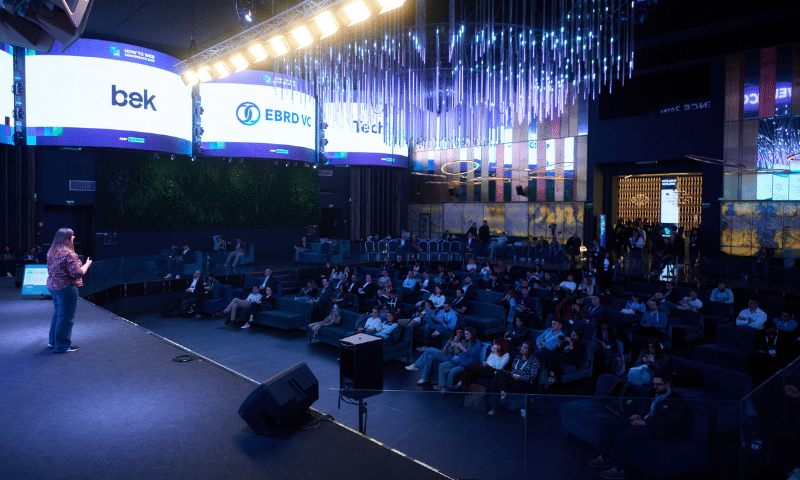How to Build Competitive Advantage with Agentic AI


Remembering Christmas 2016, when she received her first Alexa device, Gillian Armstrong was fascinated by the idea of a technology that no longer needed humans to understand it – but instead had to understand us.
With this story, the Senior Solutions Architect opened her session at How To Web, illustrating just how far artificial intelligence has come in less than a decade. From chatbots and FAQs to generative and now agentic AI, technology is clearly evolving – from reactive tools to autonomous problem-solvers.
To illustrate this evolution, Armstrong introduced “Dan,” a character based on many industry clients she has worked with:
Dan loves technology. Five years ago, he came back from a conference saying how we need to use AI in everything. Two years ago, it was generative AI in everything. And earlier this year, he stared saying what really matters now is agentic AI.
Through Dan’s story, Armstrong walked through the stages of adoption and the pitfalls that come with rushing to embrace the latest AI trend without thinking about the actual business problem.
4 principles for building agentic AI systems
Armstrong framed her talk around four guiding principles that any business should follow when considering AI systems that can act autonomously.
1. Understand your models
Not every use case requires generative AI. Many problems can still be solved with simpler and cheaper tools, Gillian points out:
If your chatbot is really simple, you don’t actually need to move to a generative AI chatbot.
Different models vary in cost, speed, and suitability. Choosing the wrong one can increase complexity without improving outcomes.
2. Balance your risks
Generative and agentic systems come with new challenges like unpredictable responses, bias, and even manipulation attempts from users. That’s why evaluation frameworks and guardrails must be built in from the start:
You need to build your systems thinking about responsibility and safety and security upfront.
Armstrong highlighted the importance of internal testing, human-in-the-loop setups for early deployments, and guardrails that can intercept off-topic or harmful interactions.
3. Your fundamentals matter
Agentic AI relies on tools, databases, APIs, document repositories to actually perform tasks. Without those business systems being accessible and modular, AI agents remain just “fancy FAQ pages”:
Those tools are gonna make your agent so much more powerful… but remember, it’s going to be able to do things. So don’t give it too much access to everything.
Armstrong stressed the need for modular business components, exposed through APIs, as the foundation for any scalable AI strategy.
4. Embrace agility
The AI journey is not about tearing down existing systems, but evolving them step by step. Businesses should integrate new technologies gradually, keeping systems flexible for future updates:
Fit the technology to your business problem. Don’t try to find the problems to solve with the technology just because it’s new and shiny.

The real break lies in moving from chatbots to true AI agents
Gillian revisited the history of customer service technology. Early websites with FAQ pages gave way to search functions, then to chatbots powered by natural language processing. Adding speech-to-text and text-to-speech made them more interactive, but still rigid. They required pre-defined intents and responses.
Generative AI improved flexibility, but at the cost of control. Large language models can generate natural responses, yet they also introduce risks. That’s why evaluation, guardrails, and careful system design are essential.
Still, Gillian argued, generative chatbots are ultimately just a smarter version of the FAQ. The real shift happens with AI agents – systems that not only understand language, but can reason, make decisions, and act on them.
Take the example of an insurance claims agent. Instead of simply answering questions, the AI recognizes when a customer actually wants to file a claim. It can ask for missing details, access the policy database, and submit the claim itself through connected tools:
Every single one of those thoughts is a call to the model. And that will start to add latency and cost. You need to be aware of that when you’re building an agent.
Because of this complexity and risk, Gillian recommended modularizing agents. Instead of building one super-agent with access to everything, companies should design multiple specialized agents, each with a narrow goal and limited set of tools:
Not only do we need to modularize our business functionality, we need to modularize our agents. We can reuse them in different ways. We can keep our risk low.
Strong foundations – smarter AI
In closing, Gillian reminded the audience that AI adoption should be a journey of evolution, not revolution. Each stage builds on the previous one, and the best results come when businesses align technology with real problems – not the other way around:
Make sure you’re building your systems now so that they’re open and agile, and you can bring these things in.
For businesses wondering how to take the next step, her advice was clear: focus on strong foundations, balance risk with innovation, and design with agility in mind. That way, agentic AI systems can move from buzzword to genuine competitive advantage.


